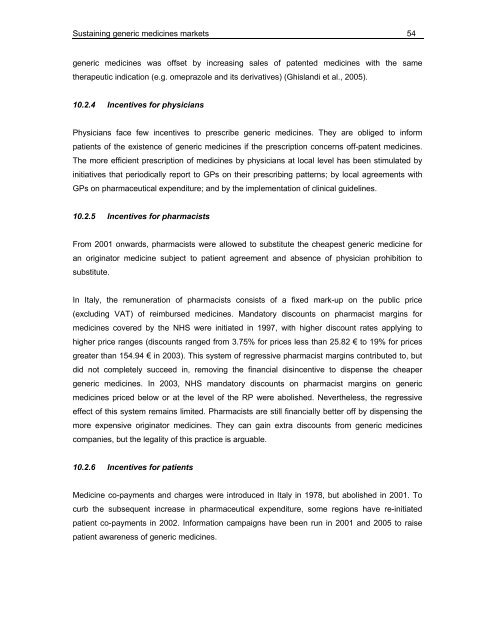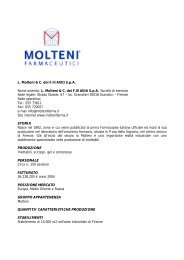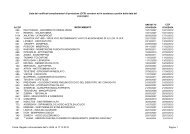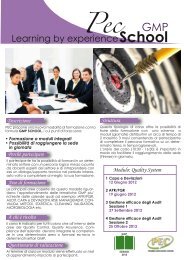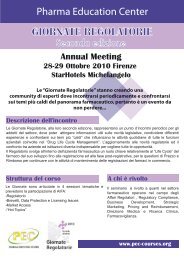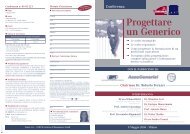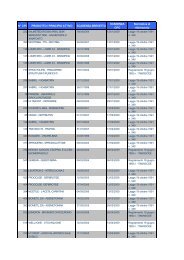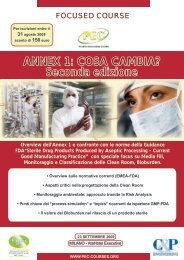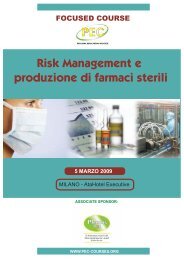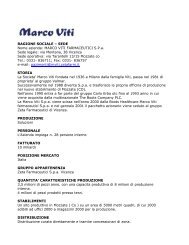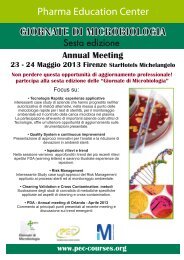Sustaining Generic Medicines Markets in Europe
Sustaining Generic Medicines Markets in Europe
Sustaining Generic Medicines Markets in Europe
You also want an ePaper? Increase the reach of your titles
YUMPU automatically turns print PDFs into web optimized ePapers that Google loves.
<strong>Susta<strong>in</strong><strong>in</strong>g</strong> generic medic<strong>in</strong>es markets 54generic medic<strong>in</strong>es was offset by <strong>in</strong>creas<strong>in</strong>g sales of patented medic<strong>in</strong>es with the sametherapeutic <strong>in</strong>dication (e.g. omeprazole and its derivatives) (Ghislandi et al., 2005).10.2.4 Incentives for physiciansPhysicians face few <strong>in</strong>centives to prescribe generic medic<strong>in</strong>es. They are obliged to <strong>in</strong>formpatients of the existence of generic medic<strong>in</strong>es if the prescription concerns off-patent medic<strong>in</strong>es.The more efficient prescription of medic<strong>in</strong>es by physicians at local level has been stimulated by<strong>in</strong>itiatives that periodically report to GPs on their prescrib<strong>in</strong>g patterns; by local agreements withGPs on pharmaceutical expenditure; and by the implementation of cl<strong>in</strong>ical guidel<strong>in</strong>es.10.2.5 Incentives for pharmacistsFrom 2001 onwards, pharmacists were allowed to substitute the cheapest generic medic<strong>in</strong>e foran orig<strong>in</strong>ator medic<strong>in</strong>e subject to patient agreement and absence of physician prohibition tosubstitute.In Italy, the remuneration of pharmacists consists of a fixed mark-up on the public price(exclud<strong>in</strong>g VAT) of reimbursed medic<strong>in</strong>es. Mandatory discounts on pharmacist marg<strong>in</strong>s formedic<strong>in</strong>es covered by the NHS were <strong>in</strong>itiated <strong>in</strong> 1997, with higher discount rates apply<strong>in</strong>g tohigher price ranges (discounts ranged from 3.75% for prices less than 25.82 € to 19% for pricesgreater than 154.94 € <strong>in</strong> 2003). This system of regressive pharmacist marg<strong>in</strong>s contributed to, butdid not completely succeed <strong>in</strong>, remov<strong>in</strong>g the f<strong>in</strong>ancial dis<strong>in</strong>centive to dispense the cheapergeneric medic<strong>in</strong>es. In 2003, NHS mandatory discounts on pharmacist marg<strong>in</strong>s on genericmedic<strong>in</strong>es priced below or at the level of the RP were abolished. Nevertheless, the regressiveeffect of this system rema<strong>in</strong>s limited. Pharmacists are still f<strong>in</strong>ancially better off by dispens<strong>in</strong>g themore expensive orig<strong>in</strong>ator medic<strong>in</strong>es. They can ga<strong>in</strong> extra discounts from generic medic<strong>in</strong>escompanies, but the legality of this practice is arguable.10.2.6 Incentives for patientsMedic<strong>in</strong>e co-payments and charges were <strong>in</strong>troduced <strong>in</strong> Italy <strong>in</strong> 1978, but abolished <strong>in</strong> 2001. Tocurb the subsequent <strong>in</strong>crease <strong>in</strong> pharmaceutical expenditure, some regions have re-<strong>in</strong>itiatedpatient co-payments <strong>in</strong> 2002. Information campaigns have been run <strong>in</strong> 2001 and 2005 to raisepatient awareness of generic medic<strong>in</strong>es.


